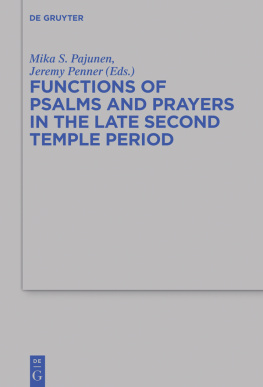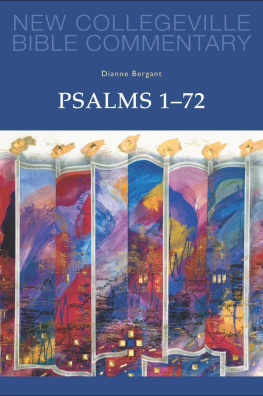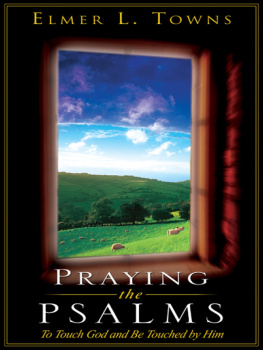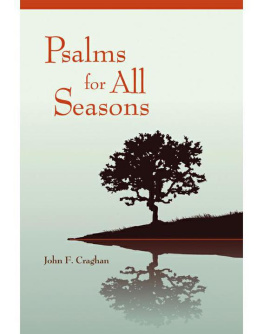Table of Contents
Guide

Functions of Psalms and Prayers in the Late Second Temple Period
Beihefte zur Zeitschrift
fr die alttestamentliche
Wissenschaft

Edited by
John Barton, Ronald Hendel,
Reinhard G. Kratz and Markus Witte
Volume 486

ISBN 978-3-11-044774-3
e-ISBN (PDF) 978-3-11-044926-6
e-ISBN (EPUB) 978-3-11-044853-5
ISSN 0934-2575
Library of Congress Cataloging-in-Publication Data
A CIP catalog record for this book has been applied for at the Library of Congress.
Bibliographic information published by the Deutsche Nationalbibliothek
The Deutsche Nationalbibliothek lists this publication in the Deutsche Nationalbibliografie; detailed bibliographic data are available on the Internet at http://dnb.dnb.de.
2017 Walter de Gruyter GmbH, Berlin/Boston
www.degruyter.com
Acknowledgements
We wish to warmly thank the following people and institutions, without whom the present volume would not have been possible. The two workshops on the functions of psalms in 2015, where the papers in this volume were first presented, were generously funded by the Joint Committee for Nordic Research Councils in the Humanities and Social Sciences (NOS-HS), the Emil Aaltonen Foundation, and the Academy of Finland Center of Exellence: Changes in Sacred Texts and Traditions (CSTT). This generous funding allowed us to assemble a talented group of international scholars for a two-part conference in Copenhagen and Helsinki. Our heartfelt thanks go to Dr. Anne Katrine de Hemmer Gudme, Dr. Trine Bjrnung Hasselbalch, Dr. rstein Justnes, Dr. Jessi Orpana, and Katri Antin for planning and organizing the conferences, the contributors for their hard work and commitment to participate, and the series editors at de Gruyter for accepting this volume in the BZAW series and for their guiding comments and suggestions. Finally, on a more personal note, we would like to thank Professor (emerita) Eileen Schuller for her tireless and generous support of her students and colleagues, for her outstanding commitment and contributions to understanding both ancient and modern worship, and for inspiring and teaching a generation of colleagues and students. It is to her that we would like to dedicate this volume.
Mika S. Pajunen
Jeremy Penner
Introduction
The articles collected in this volume are the product of a two-part conference. The first was in Copenhagen in May, 2015, the second in Helsinki in September of the same year. As the title of this book suggests, the purpose of these gatherings was to bring together a diverse set of scholars to discuss psalms and prayers in the late Second Temple period and their various functions. Eileen Schuller notes in her perspicacious introduction to this volume, that in the last decade or two a shift in focus has occurred in approaching this literature, a shift from questions of authorial intent, date of composition, and form-critical categories to matters of function and performance. While the timing is right to explore these issues, the topic is still daunting. As in times past, today, too, scholars regularly comment on the fact that the language of psalms and prayers and their respective genres are resistant to the methods and tools at the historians disposal. Hermann Gunkels groundbreaking work Die Psalmen (HKAT) in 1926 in many ways unlocked or at least provided a way forward to think about the general settings in which psalms were used. But in many ways the finer details regarding the production, collection, and use of psalms in their historical settings has continually eluded scholars, and even today, the literary setting of a psalm is often confused with its historical setting(s) (cf., e.g., Berlins article in this volume). Moreover, with the discovery of new psalms and prayers the lions share coming from the caves in the vicinity of Qumran many scholars have realized and opined that the form-critical method established by Gunkel and his followers is alone not adequate for late Second Temple psalms and prayers, nor are the established psalm categories able to reflect the changing functions and settings in which psalms and prayers were read and performed. The optimism that once characterized scholarly approaches to the psalms, that the setting of a psalm could be reached through the text, has diminished somewhat, and instead scholarship today tends to focus on the multivalent and dexterous nature of psalms and prayers and their varied settings.
To be sure, the work of Gunkel and other early form critics still remains indispensable, as it has provided the foundation upon which contemporary research has been built. Yet, by privileging the MT psalter, Gunkel set a standard for a psalms collection par excellence with which all others would be measured, and this legacy, too, has continued. As a scholar of the early 20 th century he did not consider seriously those texts on the margin of standard forms, nor the gradual changes and innovations that took place in the use and composition of psalms and prayers. It was in the late Second Temple period, for example, that for the first time we begin to see the development of fixed daily prayers; we see, too, that psalms, through the process of scripturalization, were being read in new and creative ways, both in liturgical and non-liturgical contexts.
In addition to the changing fashions of scholarly study in the academy, what makes the topic of this volume possible is the vast new corpus of material, mostly from the Judean Desert, now fully available for study. The discoveries in the middle of the 20 th century of previously unknown psalms and prayer texts, by some estimates roughly 200 new prayer texts, either liturgical, poetical, or both, have provided much new fodder with which to re-examine old questions that have continually surrounded psalms and prayer research of this period, and it has renewed scholarly questions surrounding issues of function. These new materials have also made it apparent that texts like the Septuagint Psalter and the psalms and prayers from the Cairo Genizah need to be examined anew. While the old historical-critical methods are indispensable to the historian, the addition of these newly discovered texts to the corpus of psalms and prayers from the late Second Temple period have provided new avenues for thinking about psalms and prayers, and have amply demonstrated the rich and often diverse and versatile ways these texts could be used and read in their ancient setting(s). Some of these insights have also stemmed from the increasingly interdisciplinary work of the academia. The benefits gained from engaging in theology, anthropology, sociology, psychology, ritual, cultural and literary theory, and the cognitive sciences are immediately apparent from even a cursory reading of the articles included in this volume.
Before concluding this introduction, a word about the term function may be appropriate. While some specialists in the fields of anthropology and ritual studies have rejected functionalist (capital F) approaches to rituals to explain the purpose of such acts, the term is still of some use within a discipline heavily text-dependent. It is true that historians cannot enter the minds of the authors and readers of these texts, but when surveying psalms and prayers and their usage in the late Second Temple period, it becomes apparent that many of the same texts were taken up and used differently in a variety of contexts. Psalms and prayers have a wide variety of functions: they can be vehicles for worship, they often promote certain aspects of identity formation, they can be read not only as history and mined for their assumed historicity, but also as prophecy, and were read with an eye to the future. Thus in the context of this volume, at least, the term function has been employed to point towards the varied contexts in which psalms are employed and their diverse purposes, and it is this particular aspect of function in which the term is used in this book. As such, the contributions contained herein are organized into six sections that are somehow related to the multifaceted nature of these types of literatures and their diverse functions. The fact that we could have invariably arranged the articles in this volume in a number of different sequences, and that many of the articles could have been placed in other sections, demonstrates the multifaceted nature of this type of literature, and the varied purposes and approaches that have been taken up by the readers and performers of these texts in antiquity.











